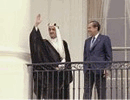|
NOTE: This is the summary of
Mahmoud Abdul-Baqi and Nansen Saleri's presentations which were given to
the CSIS in Washington on February 24, 2004
Global Outlook:
World energy demand is expected
to increase at an annual rate of 1% to 2% over the next 15 years,
reaching an annual demand of 107 million barrels per day by 2020, partly
as an anticipated consequence of growth in China, India and other South
East Asian economies.
Worldwide oil reserves at
year-end 2002 stand at 1050 billion barrels, of which 65% (or 686
billion barrels) is in the Middle East, with Saudi Arabia being the
principal player. The Middle East contributes about a third of total
world production, has a reserves-to-production life of 92 years and is
expected to play a pre-eminent role in the global energy theater.
Overview of Upstream
Operations:
Saudi Aramco's current
operations encompass 1.5 million square kilometers, comprising 85
fields, 320 reservoirs and 25% of world oil reserves. Current daily
production capability stands at 10 million barrels of crude oil and 9.6
billion cubic feet of gas. The Company's strategy calls for an annual
reserves replacement of its crude production, while adding 5 trillion
cubic feet gas reserves through an integrated exploration, delineation
and development program.
Reserves and Future
Potential:
Saudi Aramco's oil and gas
reserves conform to industry standards. Reserves attributable to
enhanced oil recovery (EOR) processes are excluded, underscoring the
conservative nature of the Company's reserves. Year-end 2003 proved oil
reserves totaled 260 billion barrels. Incremental probable and possible
reserves (over and above the 260 billion barrels) are estimated to be
103 billion barrels. Exploration, delineation and development efforts
have increased Saudi Aramco's oil initially in place from 600 to 700
billion barrels during the past 20 years. Vast unexplored acreage exists
in the Rub' al Khali desert region, the northern basin (along the border
with Iraq) and the offshore Red Sea Basin. US Geological Survey 2000
projections point to additional recoverable oil resources ranging from
29 to 161 billion barrels to be discovered in Saudi Arabia by 2025. The
Company projects its oil initially in place volume to reach 900 billion
barrels by the same date.
Reservoir Development and
Management Practices:
The stewardship of Saudi
Arabia's hydrocarbon reserves is Saudi Aramco's paramount objective. The
Company develops and manages its rich portfolio of hydrocarbon reserves,
employing state-of-the-art technological resources, best-in-class
reservoir management practices and a world-class professional workforce.
The emphasis is on long-term production sustainability and maximum
recovery.
Sophisticated diagnostic
capabilities (empowered by numerically-intensive computational models)
and comprehensive reservoir surveillance programs are two key enablers
assuring high accuracy field production forecasts, superior operational
efficiency and optimal reservoir development strategies.
Synopsis:
Saudi Aramco's proved oil
reserves of 260 billion barrels, represents a conservative figure, by
established industry (SPE/WPC/AAPG)
standards. Significant upward potential for reserves additions exists.
Oil-focused exploration and delineation efforts, application of EOR
processes and continual emphasis on existing and future technologies -
custom-fit to the Company's reservoir portfolio - will certainly
engender a major expansion in Saudi Aramco's reserves base in the
decades ahead, commensurate with global market conditions and
requirements.
The Company is committed to
maintaining its pre-eminent role as a reliable, cost-effective and
environmentally friendly global oil supplier. If called upon, sustained
daily crude production levels of 10, 12 and 15 million barrels per day
can be readily maintained through 2054 and beyond. Saudi Aramco has the
financial, organizational and technical capabilities to do so. |



